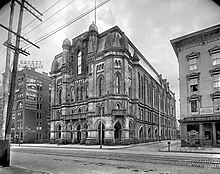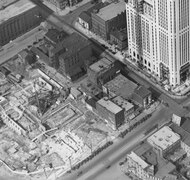Columbus City Hall (Ohio)
| Columbus City Hall | |
|---|---|
Columbus City Hall is the
City Hall was designed in a Neoclassical style by the Allied Architects Association of Columbus. It replaced offices in the Central Market building as well as a former permanent city hall. The new city hall was built from 1926 to 1928, during a period of extensive construction building the city's riverfront civic center. An additional wing was added to City Hall in 1936. Renovations took place in 1949 and 1986, and the building was determined to be eligible for the National Register of Historic Places as part of a historic district in 1988.
History


Columbus's first city hall was at the Central Market building, but it moved to a new building on Capitol Square in 1872. In 1921, a fire destroyed that building,[1][2] now the site of the Ohio Theatre.[3] James John Thomas, mayor of Columbus from 1920 to 1931, laid the cornerstone for a new City Hall on October 29, 1926.[4] The building was dedicated on April 18, 1928.
Initially built in three sections surrounding a central courtyard at a cost of US$1.7 million (equivalent to $19,930,000 in 2019),[5] a fourth section was added on the east side of City Hall in 1936 to enclose the courtyard and provide additional office space. The structure was further renovated in 1949.[6]
City Council chambers, located on the second floor, were fully restored in 1986, and feature Art Deco elements echoing those found throughout the building.[6]
In 1988, the building was included as a contributing property to the
The south patio of City Hall facing
Attributes
The five-story building, constructed of Indiana limestone, was designed by the Allied Architects Association of Columbus in the Neoclassical style.[6] Allied Architects also designed the adjacent Central Police Station building at West Gay Street and Marconi Boulevard, which opened on March 26, 1930, was vacated in 1991 with the opening of a new police headquarters building, and was renovated in 2012 as 77 North Front Street to allow the consolidation of various city government offices.[11][12] City Hall was originally also the venue for the city's Municipal Court, and its proximity to the Police Station building provided for efficient movement of prisoners between the two buildings. The former third-floor municipal courtroom in City Hall now serves as a studio for the city's cable-carried government information TV channel.[13]
Columbus City Hall is one of the buildings contained within the
Gallery
-
City Hall's plaza c. 1940s
-
The Portman Plaza in 2016, including the Statue of Christopher Columbus
-
Main entrance and east plaza of Columbus City Hall on Front Street
-
Mayor James John Thomas laying the cornerstone, 1926
-
Crowds at the cornerstone-laying ceremony, 1926
-
City Hall model, 1926
-
Construction in 1926
-
The building before its 1936 addition
See also
References
- ^ Egger, Charles, ed. (1975). Columbus Mayors (PDF). Columbus, Ohio. p. 44.
{{cite book}}:|work=ignored (help)CS1 maint: location missing publisher (link) - OCLC 52740866.
- ISBN 9781468518962.
- ^ "Columbus City Hall cornerstone dedication (1926 photo)". OhioMemory.org. December 5, 2015. Retrieved 23 March 2016.
- ^ "CONTENTdm".
- ^ a b c d "Scioto Riverfront History: City Hall". sciotogreenways.com. Retrieved 23 March 2016.
- ^ "Main Street Dam Removal & Scioto Greenways Feasibility Study". Stantec. 2012. pp. 14–15. Retrieved December 16, 2022.
- ^ "National Register of Historic Places Registration Form". National Park Service. 2016. Retrieved May 24, 2020.
- ^ Carmen, Barbara (May 21, 1996). "Columbus City Council names the south patio of City Hall 'M D Portman Plaza' at Portman's last official Council meeting". Columbus Dispatch. p. 2 C.
- ^ "Uncrating Christopher Columbus, 1955". The Columbus Dispatch. October 10, 2011. Archived from the original on June 20, 2021.
- ^ "Central Police Station (1945 photo)". Columbus Metropolitan Library Digital Collection. Retrieved 23 March 2016.
- ^ Lydia Coutré (August 14, 2012). "Columbus wants to consolidate city offices". Columbus Dispatch. Archived from the original on August 16, 2012. Retrieved 23 March 2016.
- ^ "CTV Columbus Government Television Home".
Further reading
- Barrett, Richard E. (2005). Columbus 1860-1910. Arcadia Publishing. p. 29. ISBN 9780738539621.
- Darbee, Jeffrey T.; Recchie, Nancy A. (2008). The AIA Guide to Columbus. Ohio University Press. p. 73. ISBN 9780821416846.
- Barrett, Richard E. (2002). Columbus, Ohio: 1898-1950 in Vintage Postcards. Arcadia Publishing. p. 19. ISBN 9780738519623.
- "Don't Burn Up Your Public Records". The American City. 24 (6): 577. June 1921.
- "Columbus to Have Civic Center". The Modern City. 6 (4): 11. April 1921.
External links
 Media related to Columbus City Hall (Ohio) at Wikimedia Commons
Media related to Columbus City Hall (Ohio) at Wikimedia Commons









